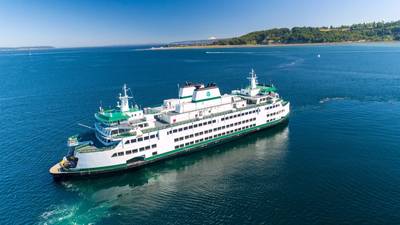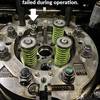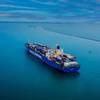Passenger Vessel Sector Faces Winding Path Back to ‘Normal’
The year just ended, 2021, might be described as being about “trying to get back to normal”, across the entire transportation spectrum, two years into the pandemic. During this time, the decarbonization and electrification waves have swept across maritime passenger transport. The passenger side of the business is dependent on multiple funding sources; increasingly, this money will be driven by environmental and social considerations.
The long-awaited funding of “infrastructure”-related projects, notably the $1 trillion Bipartisan Infrastructure Law (Infrastructure Investment and Jobs Act) signed into law in mid-November, has the potential to expand the definition of “normal”. Included in the bill is $1 billion for new ferry routes that would serve rural areas; $337 million for new ferries and shoreside terminals; and $250 million for The Green Ferries Act, a pilot project for low-carbon emission fuel (most likely electric) ferries- with multiple states positioned to see federal allocations.
Infrastructure support has crossed across the aisle- Alaska’s Representative Don Young voted “yes”, joining just 12 other Republicans in supporting the just passed legislation. Following its voyage through the House, Alaska Senators Lisa Murkowski and Dan Sullivan, both Republicans, voted for the bill; Senator Murkowski was reportedly a key participant in the bill’s actual drafting, including features that would point funds towards ferries serving rural communities. Skagway, Alaska was said to be positioning for an application as this program unfolds. Nearer term, plans were underway to repair Alaska Marine Highway’s Tustumena and possibly replace the vessel within five years at a cost of more than $200 million.
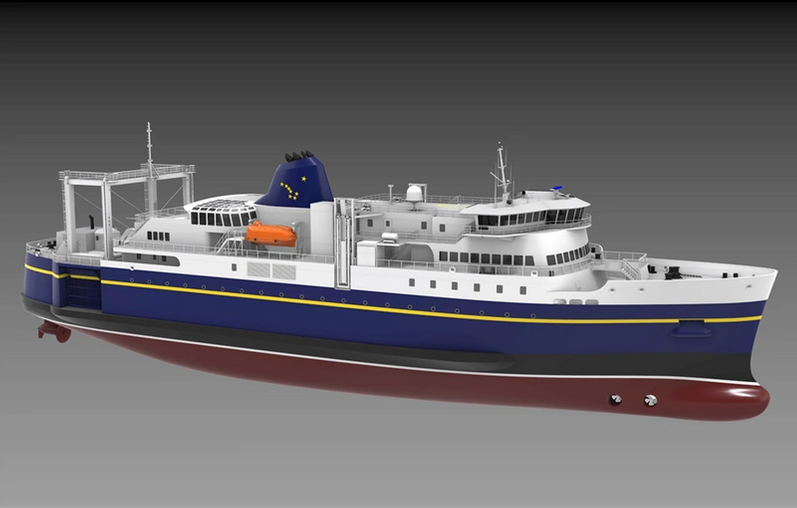 On December 4, 2021, Alaska Governor Mike Dunleavy and Transportation Commissioner Ryan Anderson announced their plan to reenergize the Alaska Marine Highway System. Among the capital investments is a new ocean-class vessel to replace the 57-year-old Tustumena ferry. (Image: Glosten)
On December 4, 2021, Alaska Governor Mike Dunleavy and Transportation Commissioner Ryan Anderson announced their plan to reenergize the Alaska Marine Highway System. Among the capital investments is a new ocean-class vessel to replace the 57-year-old Tustumena ferry. (Image: Glosten)
Down the coast, Washington State Ferries (WSF) has been looking at the potential for hybrid and electric powered newbuilds. Representative Rick Larsen, a Democrat, was a major proponent of the “green” provisions in the Infrastructure Investment bill. In late December, 2021, WSF announced a contract award to Vigor Shipyard, within Seattle, to begin construction of a new hybrid diesel electric ferry (using propulsion and energy storage systems from ABB) to be named Wishkah. The boat, similar to its existing Olympic Class vessels, is expected to enter service in 2025.
Ferries are also benefiting from established federal programs. In early December, the U.S. Maritime Administration (MARAD) awarded $12.6 million in grants to nine marine highway projects under the America’s Marine Highway Program (AMHP). The awardees included the Delaware River and Bay Authority, which will receive $600,000 to fund a comprehensive ferry master plan for the Cape May – Lewes Ferry, including development of a cleaner ferryboat design.
The landside also benefits from electrification, a key element of ports’ strategic plans that is intertwined with funding of passenger vessel terminals, at federal, state and local levels. Consider the most recent round of Port Infrastructure Development grants (another MARAD program) announced in December, 2021, where awards included $5.2 million for the “Powering the Future” electrification project in Oakland, in California’s Bay Area. A fully electric ferry powered by hydrogen fuel cells, Sea Change, a passenger vessel that will operate in the Bay Area, is in the final stages of outfitting and has been undergoing sea trials.
There are also new wrinkles in the funding of passenger vessels. Washington State, with a long-term plan for eliminating ferry emissions, has been moving toward a statewide “cap and trade” system for carbon; an unspecified slice of the funds raised through auctions of carbon allowances will be directed towards the budget for WSF (adding to traditional federal and state funding sources). In an early 2021 budget request from the ferry operator, looking forward to the mid-2030s, included estimates of $220 million needed for electrification retrofits and $300 million needed for electrifying terminals.
The passenger sector has struggled with issues similar to those facing the movement of containerized cargo and motor freight, vacillating demand and staffing shortages. While not featured on the national news alongside the anchored vessels and stacks of containers, labor difficulties have also impacted the operation of passenger vessels throughout North America, which have been bedeviled by staffing issues, even after the steady recovery in demand (and economic activity) throughout 2021. Consider that the WSF system, the largest in U.S., has now been making scheduling changes, restoring service in the wake of cancellations. Worker shortages saw sailings cut to 70% in early Autumn; one factor may have been a vaccine mandate that took effect in mid-October.
The delays in getting to the Infrastructure bill, and the inflationary environment that has emerged in the economy (tied into the pandemic, in the view of many economists), have also caused delays in marquee projects. In Maine, Casco Bay Lines, which saw 1.1 million riders in 2019 (and roughly half that number in 2020) has seen an extended timeline in arranging funding for its hybrid-powered Peaks Island Ferry, which would serve the coastal region from Portland, still in the design stage.
There is a silver lining—actually, several boatloads of blessings from all the pandemic-related bad news of 2020-2021. The pandemic, with restrictions on international travel, has fundamentally impacted the leisure sector. Put simply, U.S. travelers will stay closer to home. The shutdown of the international cruise industry throughout 2020 into 2021 has been front page news; domestically, leisure travel on river cruises also took a hit. However, in the theme of “bouncing back”, river and coastwise cruise expansion is in the cards, with many U.S. vacationers choosing to avoid travel abroad. Dr. Andrew Coggins, Professor at Pace University and well-known expert on cruise and leisure vessels, told Marine News, “The recent upsurge in the Omicron variant and resulting international travel restrictions may make U.S. river cruising more attractive. The small ship size and passenger number may make these ships more appealing. The impact of COVID should mirror the regions they sail in. One problem might be awareness in that most people don’t think of river cruising when they think of cruises.”
 River and coastwise cruises are gaining interest as many U.S. vacationers are choosing to avoid travel abroad. River cruise vessel American Jazz was delivered to American Cruise Lines in 2020. (Photo: ACL)
River and coastwise cruises are gaining interest as many U.S. vacationers are choosing to avoid travel abroad. River cruise vessel American Jazz was delivered to American Cruise Lines in 2020. (Photo: ACL)
River and coastal cruising stalwart American Cruise Lines took delivery of American Melody, its fourth in a six-vessel series being built at Chesapeake Shipbuilding, located in Salisbury, Md. The September 2021 delivery follows that of American Jazz a year earlier, American Harmony in 2019, and American Song (now operating in the Pacific Northwest) in 2018, which the yard calls “the first modern riverboat in U.S. history.” The fifth vessel, with capacity for 175 overnight passengers, American Symphony, will offer cruises on the Mississippi River system- delivery is set for late Summer 2022. The newbuilds’ bow sections feature a retractable gangway; allowing for stopovers at destinations not considered as standard tourist destinations- and therefore lacking a traditional berth. Dr. Coggins, from Pace University, noted that: “U.S. river cruising can work to increase its awareness among the public and work with the destinations to focus on local festivals, unique museums, and historic towns.” The new vessels are powered by a pair of 1,800 hp Caterpillar Tier 4 main engines, with Veth Z-drives, and Veth bow thrusters. The line is also refurbishing the 2015 built Queen of the Mississippi (and American Eagle before that) now rebranded as American Heritage, set to offer itineraries on both the Upper and Lower Mississippi River during 2022.
American Cruise destinations also include the Pacific Northwest, served by American Harmony and American Melody, and a pair of older paddle-wheelers. Dr. Coggins, the leisure travel expert, opined that, “The U.S. river cruising focuses on history (Mississippi) or scenic beauty (Ohio, Columbia, and Snake) while in Europe the focus is on history and culture. However, the Rhine is quite scenic. However, the Hudson, Snake and Columbia rivers can give the Rhine a run for its money.”
The voyage back to “normal” has seen numerous twists and turns; quite simply, the business has evolved. After suspending cruises in 2020, American Cruise came back gradually, with a careful plan for keeping passengers and crew safe in the new era of the pandemic; pre-boarding COVID tests are now de rigueur. They note that: “Each American Cruise Lines ship carries a Certified Medical Officer and has quarantine/isolation rooms available. American Cruise Lines has partnered with Vikand Solutions, a maritime health specialist, to provide medical services, including COVID-19 testing and coordination with medical facilities in each port of call.”
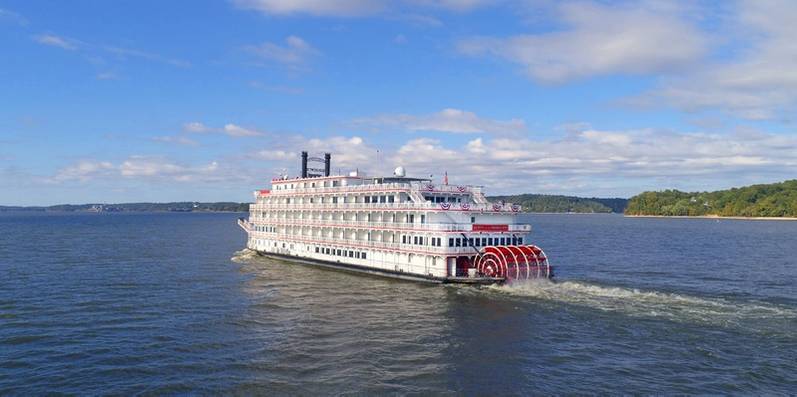 In September, American Cruise Lines announced that its fleet of four classic paddlewheelers will be undergoing a major redesign, refit and rebranding. (Photo: ACL)
In September, American Cruise Lines announced that its fleet of four classic paddlewheelers will be undergoing a major redesign, refit and rebranding. (Photo: ACL)
A new entrant, the international small ship specialist, Viking Cruises, is set to enter the U.S. market, with its 386 passenger newbuild Viking Mississippi set to deliver from Edison Chouest’s LaShip yard in Houma, La. With its riverboat fleet, Viking has been an early adopter of diesel electric propulsion. Though headquartered in Europe, the company is on a path to achieving Jones Act compliance through an arrangement where the vessel (costing nearly $200 million, based on documents related to its financing submitted to MARAD) is owned by several U.S. based “citizen” affiliates of Edison Chouest, and time-chartered to a U.S “non-citizen” entity tied to Viking. In late 2021, a number of U.S. based competitors in the river and coastwise cruising market had voiced concern to MARAD regarding the characterization of the charter. In effort to meet the complicated set of Jones Act requirements, the operator of the vessel would be a U.S. citizen Edison Chouest affiliate, putting it onto a time charter to Viking (with Viking providing hospitality and hotel functions).
Timing is everything, and happily on the East Coast expansions are set to coincide with the return to the office for riders who worked from home during the pandemic. The Staten Island Ferry, part of New York City’s Department of Transportation, took delivery of the first of three new 4,500 double-ended passenger vessels designed with quick turnarounds in mind, SSG Michael H. Ollis, from Eastern Shipbuilding (in western Florida), in Summer 2021; the vessel was formally commissioned in October 2021. The ferry, constructed at the shipyard’s Allanton and Port St. Joe locations, benefits from Elliott Bay Design Group’s naval architecture. The second vessel in the series, Sandy Ground, departed from Port St. Joe in early December, 2021; it will enter service in Spring, 2022, after final work at a local yard on Staten Island. A third ferry, Dorothy Day, is set for a late 2022 delivery.
Each double ended ferry features four ABS Electro-Motive Diesel (EMD) L12ME23B EPA Tier 4 marine propulsion engines, and one Voith Schneider propeller, at each end of the vessel. The vessels’ cost has been reported at around $85 million, each. The ferry service, linking Staten Island to lower Manhattan, curtailed operations in the early days of the pandemic, with ridership down by 90-95% in Spring 2020. It returned to its full 24/7 schedule in late Summer, 2021; though ridership is still below pre-pandemic levels, it has been on the upswing as employees return to their offices.
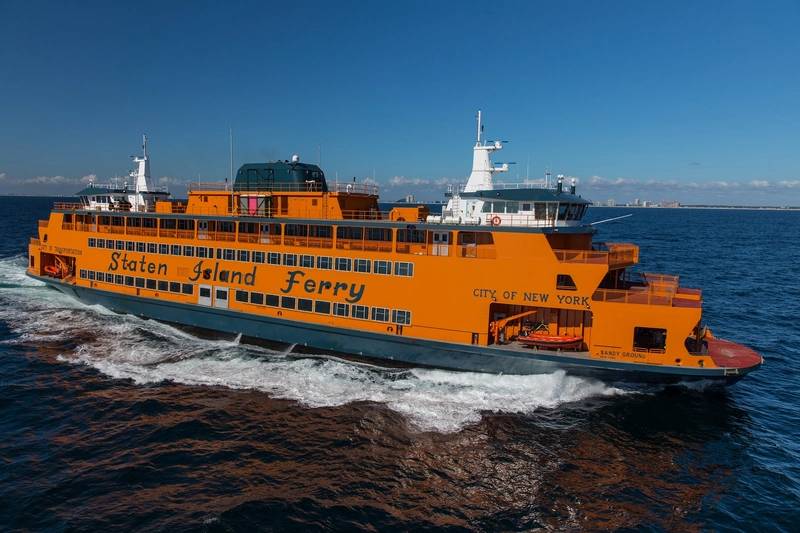 (Photo: Eastern Shipbuilding Group)
(Photo: Eastern Shipbuilding Group)
Passenger vessels continue to grow in importance as cities seek new transport options. NYC Ferries, with a fleet of smaller boats with names like Tooth Ferry and Ferry Godmother, run by Hornblower for the city’s Economic Development Corp, has continued to connect outer parts of the sprawling city with Manhattan’s downtown and midtown business districts, which will soon be seeing the imposition of congestion pricing. The boats, Incat Crowther designed high speed catamarans (with two series, 150 passenger, and 350 passenger), were built at Metal Shark (which subsequently absorbed Horizon Shipbuilding, also building boats in the series) and several other yards. In New York, the Trust for Governors Island (once the site of a Coast Guard base and now the site of an emerging park and recreation area) is soliciting bids (based on specifications from Elliott Bay Design Group) for a “hybrid” passenger/ vehicle ferry, with the potential for fully electric operation in the future. The island, which is home to the well-known Harbor School, is currently served by NYC Ferries.
New York’s outgoing Mayor, Bill De Blasio, in a mid-December press conference, said, “This used to be a city with ferries all over the place. Over the years it became very, very few. We’ve turned that around with NYC Ferry, reaching neighborhoods all over the five boroughs, including a lot of neighborhoods that were transportation deserts. And we’re helping people get out of their cars.” For now, ordering has ceased, but ferries will continue to be part of New York’s transportation scene. De Blasio added, “We’re helping people have a better way to get around. And it’s exciting because NYC Ferry has only just begun…”
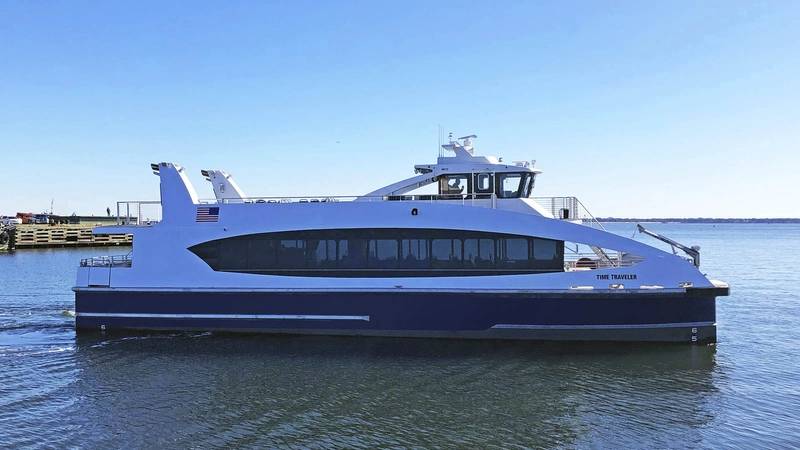 A large newbuild series has wrapped up for NYC Ferries, run by Hornblower. (Photo: Metal Shark)
A large newbuild series has wrapped up for NYC Ferries, run by Hornblower. (Photo: Metal Shark)




